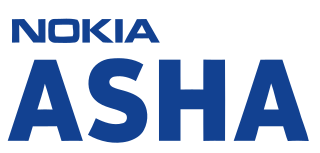
Typing is the process of writing or inputting text by pressing keys on a typewriter, computer keyboard, mobile phone or calculator. It can be distinguished from other means of text input, such as handwriting and speech recognition. Text can be in the form of letters, numbers and other symbols. The world's first typist was Lillian Sholes from Wisconsin in the US, the daughter of Christopher Sholes, who invented the first practical typewriter.
Pantech Inc. is a South Korean company that manufactures mobile phones. Established in 1991, its market is mainly domestic with partners in the United States, Japan, China, Europe and finally Vietnam. In 2012 Pantech was the second best-selling handset maker in South Korea, according to Gartner. In 2013 Samsung Electronics bought a 10% stake in Pantech. Pantech also partners with PCD for specialized phones.

T9 is a predictive text technology for mobile phones, originally developed by Tegic Communications, now part of Nuance Communications. T9 stands for Text on 9 keys.
Autocorrection, also known as text replacement, replace-as-you-type or simply autocorrect, is an automatic data validation function commonly found in word processors and text editing interfaces for smartphones and tablet computers. Its principal purpose is as part of the spell checker to correct common spelling or typing errors, saving time for the user. It is also used to automatically format text or insert special characters by recognizing particular character usage, saving the user from having to use more tedious functions. Autocorrection is used in text messaging or SMS, as well as programs like Microsoft Word.
A text entry interface or text entry device is an interface that is used to enter text information in an electronic device. A commonly used device is a mechanical computer keyboard. Most laptop computers have an integrated mechanical keyboard, and desktop computers are usually operated primarily using a keyboard and mouse. Devices such as smartphones and tablets mean that interfaces such as virtual keyboards and voice recognition are becoming more popular as text entry systems.

The SGH-F700, marketed as the Ultra Smart F700, is a mobile phone manufactured by Samsung. Using Vodafone as its network provider, the phone was first introduced at the 3GSM World Congress that was held in February 2007. Sales to the European market started November 2007.

The BlackBerry Storm is a touchscreen smartphone developed by Research In Motion. A part of the BlackBerry 9500 series of phones, it was RIM's first touchscreen device, and its first without a physical keyboard. It featured a touchscreen that responded like a button via SurePress, Research In Motion haptic feedback technology. Its competitors included Apple's iPhone, the Palm Pre, the T-Mobile G1 by HTC and the HTC Touch family.
Samsung SCH-U940 is a Verizon Wireless touch-screen phone made by Samsung. The Glyde was based on the popular European Croix, but was later adapted for the United States. It was released in late May 2008 in Verizon stores. As of August 2009, the phone is no longer listed for sale on Verizon's website. The phone features touch screen navigation, a 2.0-megapixel camera/camcorder with flash, customizable shortcut menus, and a full HTML browser. The phone has been replaced by a newer version, the Samsung Rogue.
Swype was a virtual keyboard for touchscreen smartphones and tablets originally developed by Swype Inc., founded in 2002, where the user enters words by sliding a finger or stylus from the first letter of a word to its last letter, lifting only between words. It uses error-correction algorithms and a language model to guess the intended word. It also includes a predictive text system, handwriting and speech recognition support. Swype was first commercially available on the Samsung Omnia II running Windows Mobile, and was originally pre-loaded on specific devices.
The form factor of a mobile phone is its size, shape, and style, as well as the layout and position of its major components.
The Samsung SGH-i907, marketed as the Samsung Epix in the United States by AT&T Wireless, is a Windows Mobile-based quad-band GSM smartphone manufactured by Samsung.

The Samsung Omnia II GT-I8000(H/L/U) is a multimedia smartphone announced at Samsung Mobile Unpacked on June 15, 2009. Earlier Omnia II releases run Windows Mobile 6.1, however they are upgradable to version 6.5 Professional. There is also an unofficial and experimental Android version available. Verizon is the official US carrier for this phone and released it in December 2009.
The LG GR500 is a mobile phone manufactured by LG Electronics, which features a touch screen and QWERTY keyboard on AT&T's 3G network. It was released April, 2009, compared to 2007 for the first iPhone and 2008 for the first Android phone. It offers a flash for the 2.0 mega pixel camera, GPS, multi tasking, a menu or favorite contacts, and a microSD slot for music, pictures, and video. Voice dialing and video share are among the features on this phone. Newer models of the phone also include a front-facing camera for video chat, that is incapable of recording video or pictures. The LG Xenon does not have Wi-Fi capability.

The Samsung Impression is a slider-style mobile phone manufactured by Samsung Electronics. First announced on March 30, 2009, it was released on April 7, 2009. It was the first phone manufactured for the United States to have an AMOLED touch-screen.

The LG Mobile World Cup was an international competition held on January 14, 2010, by LG Electronics in which participants competed using their texting speed and accuracy. It was held at Gotham Hall in New York City. Thirteen teams representing their countries competed for a total of $130,000 USD in prize money.

The Nokia Asha 303 is a QWERTY messenger phone powered by Nokia's Series 40 operating system. It was announced at Nokia World 2011 in London along with three others Asha phones - the Nokia Asha 200, 201 and 300. The 303 is considered to be the flagship of the Asha family. Its main features are the QWERTY keyboard and capacitive touchscreen, the pentaband 3G radio, SIP VoIP over 3G and Wi-Fi and the ability to play Angry Birds which were all never seen before on a Series 40 phone. Nokia Asha 303 is available in a number of languages depending on which territory it is marketed for. Models sold in South Asia support at least eight languages: English, Hindi, Gujarati, Marathi, Tamil, Kannada, Telugu and Malayalam.
ETAOI keyboard is a text input software for touch screen-reliant devices. It is based on ETAOI method for coding.

Fleksy is a third-party, proprietary virtual keyboard app for Android and iOS devices. It attempts to improve traditional typing speed and accuracy through enhanced auto-correction and gesture controls. Fleksy uses error-correcting algorithms that analyze the region where the user touches the keyboard and feeds this through a language model, which calculates and identifies the intended word. Swiping gestures are used to control common functions, such as space, delete, and word correction.
The KALQ keyboard,, is a keyboard layout that has been developed by researchers at the Montana Tech, University of St Andrews and the Max Planck Institute for Informatics as a split-screen keyboard for thumb-typing, which is claimed to allow a 34% increase in speed of typing for the people who use touchscreen. KALQ was released as a free app, albeit a beta, for Android-based smartphones. Although the KALQ project received some buzz in tech media, as of early 2017, the latest public version is dated October 2013, and still labelled a beta.

Windows Phone 8.1 is the third generation of Microsoft's Windows Phone mobile operating system, succeeding Windows Phone 8. Rolled out at Microsoft's Build Conference in San Francisco, California, on April 2, 2014, it was released in final form to Windows Phone developers on April 14, 2014 and reached general availability on August 4, 2014. All Windows Phones running Windows Phone 8 can be upgraded to Windows Phone 8.1, with release dependent on carrier rollout dates.










